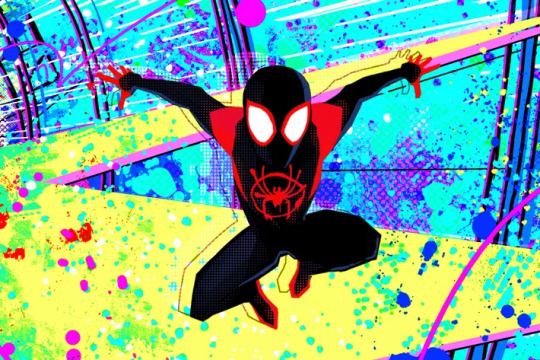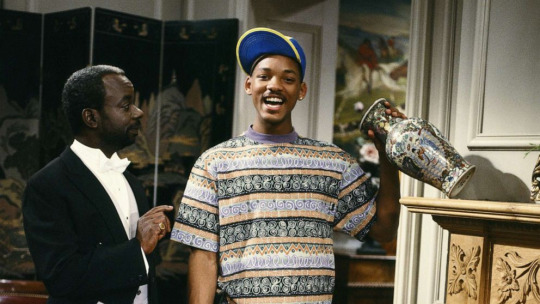Text
Entry #4: Summary
For my multimedia journal, I focused on researching material that prioritized representation.
In "The Fresh Prince of Bel-Air," the idea of African Americans breaking free of stigmas regarding a socially static culture is presented through the experiences of the main character: Will Smith. In "Spider-Man: Into the Spider-Verse," the idea that anyone can be a hero is shown through the racial and ethnic diversity of the protagonists in the film. In the Asian and African studies blog, the idea that there are intersections and divergences between cultures in characteristics and/or challenges that they face is made clear by research on historical contexts, cross-race relations, and current events.
Each piece of material was from a different medium, but that doesn't mean they can't have overlapping messages. My journal is proof of that, and I am really pleased with how it turned out.
0 notes
Text
Entry #3: Social Media/Internet
For the social media/internet portion of my journal, I chose to look at an Asian and African studies blog. This blog is a part of the British Library, the national library database of the United Kingdom. It contains posts from several collaborators and authors pertaining to Asian and African culture, as well as intersecting points between the two.

Regarding our course content, I'd say that this blog ties in well with multiculturalism and African American identity in photography. The blog itself often features content that highlights the rich, diverse cultures and histories of Asia and Africa. This content can help contextualize the multicultural dimensions of identity and representation in photography. For example, understanding the historical and cultural backgrounds of different communities can inform how multiculturalism is portrayed and discussed in photographic works. Photographers often draw on diverse cultural elements to reflect multicultural realities, and the blog’s resources can offer deeper insights into these cultural contexts. As for the African American identity in particular, it is shaped in photography by a range of historical, social, and cultural influences. The blog provides historical documents, visual materials, and scholarly articles that explore the intersections of African cultures with African American experiences. This can enrich understanding of how African American photographers draw upon African heritage and how these influences manifest in their work.

This blog represents racial and ethnic identities by offering a wide range of historical, cultural, and scholarly perspectives on the regions it covers. It then engages with these themes and generates conversation about race, ethnicity, and cultural diversity in multiple ways. First, the blog features historical documents, manuscripts, photographs, and other artifacts that reflect the diverse cultures and societies of Asia and Africa. These materials often highlight how racial and ethnic identities were perceived and represented historically, providing insight into the complexities of these identities over time. Second, cultural narratives are presented through stories, biographies, and cultural practices from various ethnic groups, which work to illustrate the diverse ways in which racial and ethnic identities have been expressed and understood. This can include features on traditional practices, historical figures, and key events that have shaped racial and ethnic identities in these regions. As for creating conversation about race, ethnicity, and cultural diversity, the blog explores the interactions between different cultures and how these interactions have influenced racial and ethnic identities. By examining historical trade routes, migration patterns, and colonial histories, it provides a broader understanding of how identities are shaped through cross-cultural exchanges. Some articles actually engage with contemporary discussions about race and ethnicity, reflecting on how historical legacies impact modern issues. This can include examining ongoing challenges related to racial and ethnic diversity, representation, and social justice.

Overall, the Asian and African studies blog in the British Library is a great resource for multicultural topics, and it connects to our class in several ways. I definitely enjoyed exploring its contents, and I'd recommend it to anyone looking for cultural insight regarding both the past and present.

Works Cited
Deborah Willis, "Picturing Us: African American Identity in Photography" (1994)
Gregory Jay, "Terms for Multicultural Studies: Defining "Race," "Ethnicity," and "Nationality"" (2011)
https://blogs.bl.uk/asian-and-african/




Thomas Allen Harris, "Through a Lens Darkly: Black Photographers and the Emergence of a People" (2014)
0 notes
Text
Entry #2: Film
For the film portion of my journal, I chose to examine the 2018 Marvel movie "Spider-Man: Into the Spider-Verse." It's an animated film that explores the concept of the multiverse, where multiple dimensions and alternate realities coexist. The story centers on Miles Morales, a teenager who gains spider-like superpowers and becomes the Spider-Man of his universe. When a super-collider causes various Spider-People from different dimensions to converge in Miles' world, he must team up with these alternate Spider-Heroes to stop a catastrophic threat and find a way to return them to their respective realities.

When looking at our class topics, "Spider-Man: Into the Spider-Verse" is closely linked to our content regarding multiculturalism and the Hapa Project. This film makes a point to represent diverse identities and experiences throughout the characters in the cast. In particular, it celebrates cultural diversity through its various Spider-People, who come from different backgrounds, such as African-American, Hispanic, and Japanese. Each character brings a unique cultural perspective to the story, reflecting the idea that heroism and personal identity are multifaceted and inclusive. The movie highlights the richness of different cultures and how they contribute to a broader, shared experience. When looking at The Hapa Project, it focuses on the experiences of individuals who are of mixed Asian and Pacific Islander heritage, often exploring themes of identity, belonging, and representation. Miles Morales is of African-American and Puerto Rican descent, embodying a similar sense of mixed cultural identity. His character resonates with the Hapa Project's themes by showcasing how mixed heritage individuals navigate their identities and connect with various cultural influences.

This film also elaborates on racial and ethnic identities beyond the appearance of each character. First, the film juxtaposes culturally specific elements with universal themes. For instance, the depiction of Miles' family life includes cultural references like his father’s role as a police officer, his mother’s protective nature, and the importance of family ties and community. These specifics provide insight into his background while emphasizing universal experiences of family dynamics, adolescence, and self-discovery. Second, the film’s animation style reflects diverse artistic influences, from graffiti and street art associated with urban culture to the more traditional comic book aesthetics. This visual diversity mirrors the variety of cultural backgrounds represented in the characters, making the film a celebration of both cultural and artistic diversity. Lastly, the interactions between characters from different dimensions foster conversations about cultural and generational differences. For example, the older Spider-Man (Peter B. Parker) has to mentor the younger Miles, bridging generational gaps while also navigating cultural nuances. These dynamics can prompt discussions about mentorship, cultural transmission, and the evolving nature of identity.

All in all, "Spider-Man: Into the Spider-Verse" is a champion for cultural representation in the film industry, and its story reminds us that while our backgrounds shape our experiences, the essence of heroism and personal growth is something that transcends individual differences.

Works Cited
https://kipfulbeck.com/hapa-me/

https://www.forbes.com/sites/insertcoin/2018/12/16/spider-man-into-the-spider-verse-is-not-just-a-must-see-its-a-must-see-in-theaters/

https://www.imdb.com/title/tt4633694/

https://www.netflix.com/tw-en/title/81002747
https://www.vulture.com/2019/01/how-spider-man-into-the-spider-verse-changed-animation.html

Kip Fulbeck, "The Hapa Project: 10 Years After" (2013)
Susan Saulny, "Black? White? Asian? More Young Americans Choose All of the Above" (2011)
0 notes
Text
Entry #1: (Post) TV Show/Series
For my TV series selection, I chose to research and watch the 1990 sitcom "The Fresh of Bel-Air" by Andy & Susan Borowitz. The story features a 20-year-old Will Smith (at the time) as a teenager from a tough neighborhood in West Philadelphia. Will’s mother, fearing for his safety and ability to grow in an underserved black community, sends him to live in Bel-Air, California with their wealthy relatives, the Banks.

The core relationship of this show to our class is in how it challenges the societal stigma that African American culture/identity is static. It flipped that idea on its head and instead aimed to give African Americans a fluid identity. A notable quote pertaining to and promoting this idea from one of our readings is by Nicholas Mirzoeff, who states "what matters is the internal quality of difference that may be as effectively concealed as revealed by external appearance." In this, Mirzoeff is saying that a lot of what goes into what is perceived by others is invisible to the naked eye. Because of this, people grab onto the tangible reasoning they have, and race and/or ethnicity end up unjustly being that scapegoat/culprit in most cases.

To emphasize this further, there is an episode called "Papa's Got a Brand New Excuse" where Lou (Will's father) suddenly reappears into his life and then abruptly exits, which leaves Will upset and questioning why his father doesn't want to be there for him. For context, Will's father left him at the age of five after he divorced Will's Mother Vy. This type of baggage makes Will's feelings more understandable, and shows the internal struggle that we would anticipate from a person whose father decided to show up and leave quickly afterwards when they were out of their life for 14 years. It highlights an unfortunate trend in the African American community, and further proves Mirzoeff's point.

All in all, "The Fresh Prince of Bel-Air" is one of the most notable and influential shows within the scope of U.S visual culture, and its difficult (but important) topics and messages are perfectly delivered to us through the medium of a TV sitcom. It epitomizes what Professor Gregory Jay says in one of our articles pertaining to multiculturalism, which is that "race has no significant meaning as a way of categorizing human differences."

Works Cited
Gregory Jay, "What is Multiculturalism?" (2011)
https://abcnews.go.com/GMA/Culture/smith-virtually-reunites-fresh-prince-bel-air-cast/story?id=70414308

https://lior-kz.medium.com/awards-and-unanswerable-questions-from-the-first-fresh-prince-basketball-episode-4d199f1fa0e5

https://lithub.com/how-the-fresh-prince-of-bel-air-tackled-the-topic-of-black-fatherhood/

https://www.max.com/shows/fresh-prince-of-bel-air-1990/d3f86fb1-c3d6-4715-874a-579689f5f437
https://www.reddit.com/r/Xennials/comments/19fgzz1/fresh_prince_episode_where_he_asks_uncle_phil_how/

Nicholas Mirzoeff, "The Shadow and the Substance" (2003)
1 note
·
View note